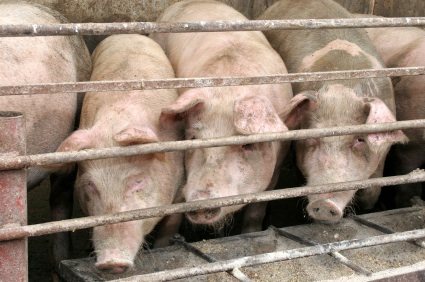 Want some Chinese dollar reserves in that ration? Like a pig pumped full of antibiotics, gorged on corn, soy, and industrial byproducts, and stuffed into a room with thousands of its peers huddled over a lagoon of their own waste, the U.S. meat industry is feeling a bit haggard just right now. Like many U.S. industries, Big Meat has relied heavily on easy credit for years, and is getting pinched by the credit crunch. Also, recession-straped consumers are eating out less and opting for cheaper items down the food chain, slowing the growth of meat consumption. Finally, corn and soy prices — while down significantly from last year’s highs — remain at historically elevated levels.
Want some Chinese dollar reserves in that ration? Like a pig pumped full of antibiotics, gorged on corn, soy, and industrial byproducts, and stuffed into a room with thousands of its peers huddled over a lagoon of their own waste, the U.S. meat industry is feeling a bit haggard just right now. Like many U.S. industries, Big Meat has relied heavily on easy credit for years, and is getting pinched by the credit crunch. Also, recession-straped consumers are eating out less and opting for cheaper items down the food chain, slowing the growth of meat consumption. Finally, corn and soy prices — while down significantly from last year’s highs — remain at historically elevated levels.
In other words, an industry that doles out pain to workers, animals, communities, and the environment as a matter of course is now itself writhing in pain. Shares of Tyson, which controls hefty portions of the U.S. beef and poultry markets, have rebounded recently but still trade at about half of July 2008 levels. Pilgrim’s Pride, the nation’s largest poultry producer, remains mired in bankrupcty; its shares trade at about 10 percent of Juy 2008 levels. And Smithfield Foods, the globe’s largest pork packer, has shed about two-thirds of its value since July.
Yet even as these cash-strapped giants stagger, the factors that made them investor darlings for years remain in place. In short, global demand for cheap meat will almost certainly rise in the mid- and long-term — and these companies know how to churn out lots of meat at low cost. That’s probably why the state-owned Chinese food-and-agribusiness giant Cofco is considering buying out Smithfield at a significant premium to its share price, according to an Associated Press report. Cofco must think that the meat industry’s problems are merely short-term hiccups. This is not the first dalliance between the U.S. pork giant and the Chinese conglomerate. Early last year, Smithfield began exporting pork to China through Cofco; and in July, Cofo bought 5 percent of Smithfield shares. China is the world’s largest pork producer, but most hog production still comes from small farms. At the time of last year’s stock deal, Cofco announced plans to consolidate production along the U.S. model. Cocfo had been slaughtering a half million hogs, mostly raised on contract by small-scale farms, Forbes reported at the time. With Smithfield’s expertise as a guide, Cofco planned to boost that number to 10-15 million hogs within five years — “raised in accordance with standards and practices prevailing in the United States,” Forbes reported. In other words, Cofco and Smithfield were plotting the rapid-fire CAFOization of Chinese pork production.
As a state-owned entity, Cofco has access to the Chinese government’s vast dollar reserves and could make a Smithfield deal happen. Such a deal would represent a bet by the Chinese government that U.S. regulators have no serious plans on cracking down on CAFOs for antibiotic abuse, water and air degradation, and deplorable labor practices. Let’s hope Cofco execs don’t know something we don’t.



